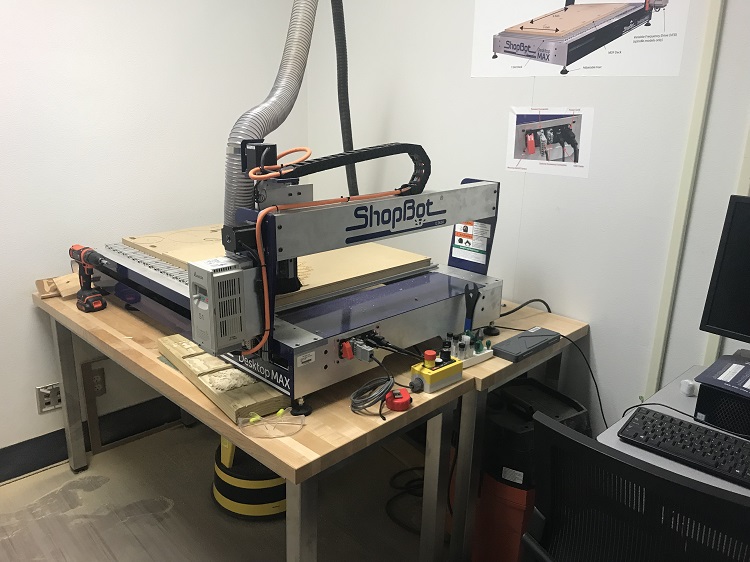CNC Router
CNC is the acronym for Computer Numerical Control. It refers to the idea of controlling machine tools via computer. The CNC router is a precise, powerful and expensive piece of machinery. Each use must be approved by an I-Create Lab Staff Member.
How can I use the CNC router at the I-Create Lab?
Patrons who wish to use the CNC router must present a SandDollar card or a valid ID. Patrons must complete a safety orientation session. The orientation session covers the basic operation of CNC routers, safety practices, basic tools and techniques to create the artwork files and the I-Create Lab CNC Router Policies. Patrons must sign an I-Create Waiver form. Patrons must be 18 years or older. Patrons must be present to supervise their CNC router job at all times.
Patrons must make a reservation to utilize the CNC router. Use the link below to schedule a reservation.
What type of CNC router does the I-Create Lab have?
The I-Create Lab has a ShopBot Desktop Max. It has a cutting area of 36” x 24” x 3.5”.

Cost
There will be a charge of $2.00* per half hour for current students, faculty and staff.
There will be a charge of $3.00* per half hour for community users.
*30 minute minimum
Sales tax will be added to all purchases, unless the patron can provide a tax-exempt form.
How does CNC milling work?
CNC (Computer Numerical Control) mills can be thought of as computer-controlled carving machines. A cutting tool, similar to a drill or routing bit, is spun at very high speeds and moved to cut/carve the material to be machined. This is a ‘subtractive’ manufacturing process where the process starts with a block of solid material and results in a finished piece along with waste material (sawdust, plastic chips, metal filings, etc.)
There are two basic styles of milling on the CNC desktop mills: 2D (sometimes called 2.5D) milling and 3D milling. Generally, 2D milling is considered similar to routing or etching, where a flat surface is machined with relief marks or cut out in a flat shape (the cutting tool only moved left-right and forward-back while cutting). In 3D milling the cutting tool also moves in the up-down direction while cutting to form a complete three-dimensional shape.
What materials and tooling can I use?
In general, small desktop mills can work with wood, plastics and machinable foams and waxes. Under certain conditions, the mill can also machine non-ferrous metals such as aluminum, copper, brass and others. Patrons are expected to provide their own materials to be used in the CNC desktop router.
The library will supply a limited selection of cutting tools.
Shopbots can cut wood, plastics, composites, and non-ferrous metals such as aluminum, brass and copper.
Shopbots cannot cut steel
What software is used to create designs?
For cutting and engraving shapes (2D milling), the CNC mill requires a ‘vector’ file. Vector shapes can be created and modified using Inkscape (free), or with a variety of CAD (Computer Aided Design) programs, including the free, browser-based Tinkercad. Adobe Illustrator and CorelDraw are popular commercial programs used to create vector art.
Import file types:
| File extension | Description |
|---|---|
| STL | CAD orientated 3-D design packages and scanning systems |
| DXF | Many CAD systems-data must consist of meshes or triangles |
| 3DS | 3-D Studio and many other animation orientated packages |
| OBJ | Wavefront |
| SKP | SketchUp software files |
| V3M | VectorArt 3-D or Design & Make clipart models |
| LWO | Lightwave 3-D Object model |
| 3DM | Rhino 3-D Model |
| WRL | Netscape 3D Live Picture |
And image trace on BMP